Below are the houses located at 45 (top) and 48 Walnut Street in the Prospect Hill neighborhood of Somerville, a suburb of Boston (photos from Wikipedia and Somerville tax assessor):
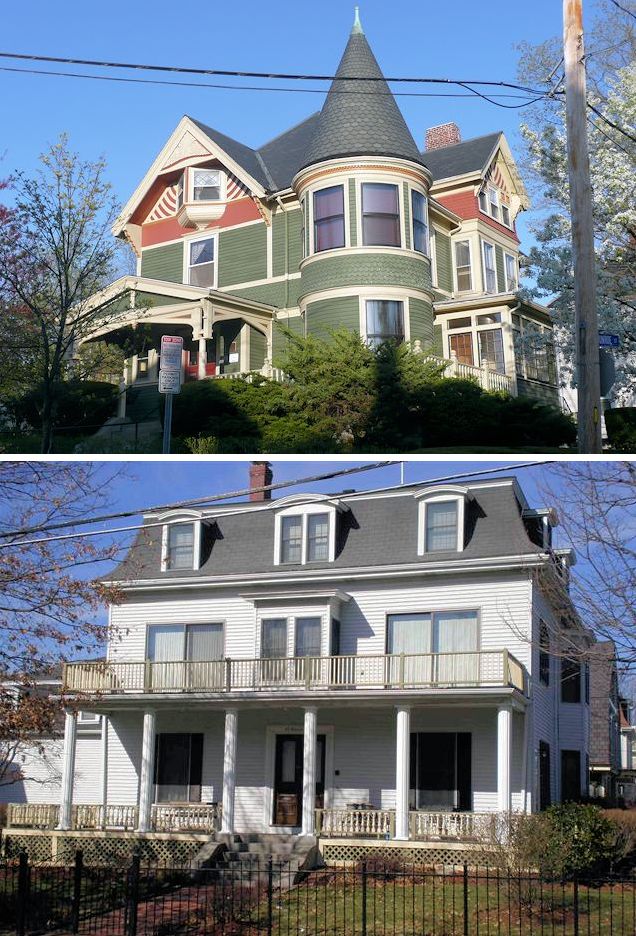 Below is the Livestock Exchange Building at 131 East Exchange Avenue at the stockyards, known as “the Wall Street of the West,” the difference being that the stock it exchanged was on the hoof, not on paper, when the stockyards and packing plants were in their, well, hayday:
Below is the Livestock Exchange Building at 131 East Exchange Avenue at the stockyards, known as “the Wall Street of the West,” the difference being that the stock it exchanged was on the hoof, not on paper, when the stockyards and packing plants were in their, well, hayday:
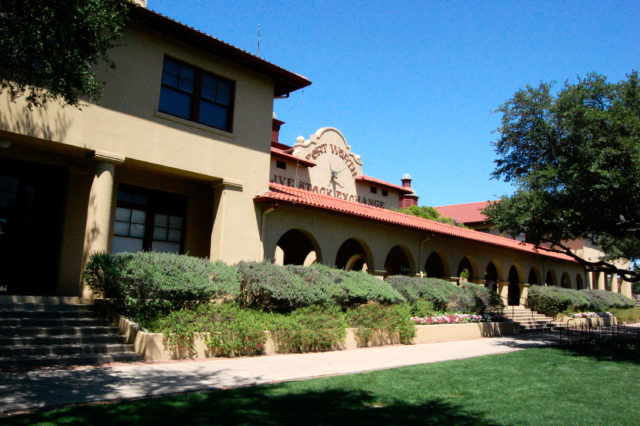 What connection could there be between an 1872 Second Empire mansion and an 1890 Queen Anne mansion in Massachusetts and a 1903 mission revival office building on the North Side?
What connection could there be between an 1872 Second Empire mansion and an 1890 Queen Anne mansion in Massachusetts and a 1903 mission revival office building on the North Side?
For the answer, reset the clock of your smartphone to July 26, 1887.
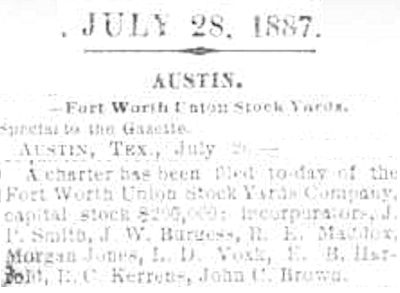 That’s when John Peter Smith, R. E. Maddox, J. W. Burgess, and other local entrepreneurs chartered the Fort Worth Union Stock Yards Company. North of town they built a stockyards and a two-story wooden building to house a hotel for one hundred guests, a livestock exchange, and a bank.
That’s when John Peter Smith, R. E. Maddox, J. W. Burgess, and other local entrepreneurs chartered the Fort Worth Union Stock Yards Company. North of town they built a stockyards and a two-story wooden building to house a hotel for one hundred guests, a livestock exchange, and a bank.
 The Fort Worth Union Stock Yards opened in 1889.
The Fort Worth Union Stock Yards opened in 1889.
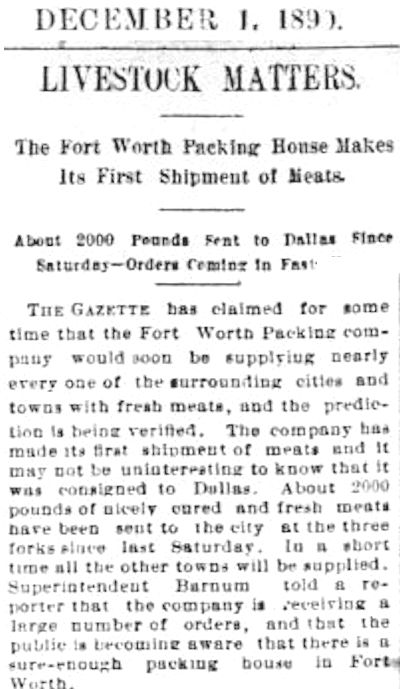 The next year local entrepreneurs, including Smith, J. R. Hoxie, and M. G. Ellis, formed Fort Worth Packing Company and opened a packing plant southeast of the Union Stock Yards.
The next year local entrepreneurs, including Smith, J. R. Hoxie, and M. G. Ellis, formed Fort Worth Packing Company and opened a packing plant southeast of the Union Stock Yards.
 Now Fort Worth had a stockyards and a packing plant.
Now Fort Worth had a stockyards and a packing plant.
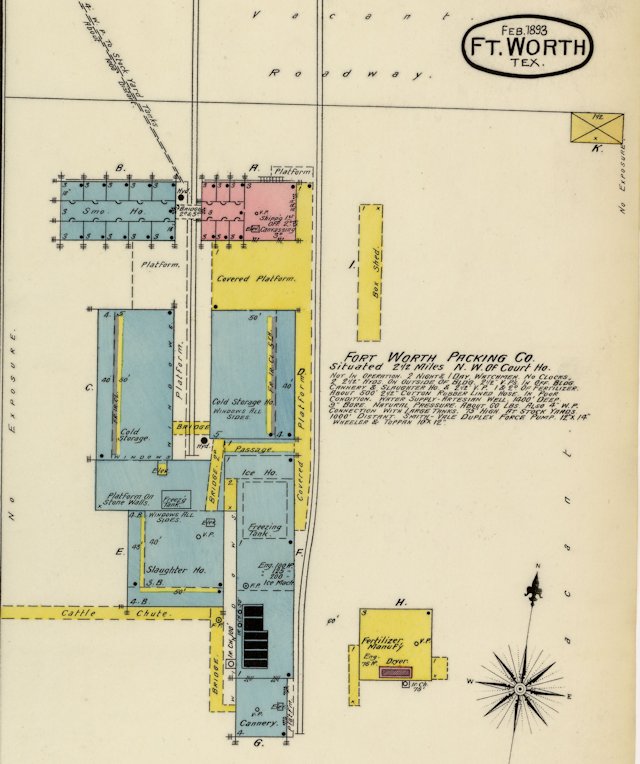 But the packing plant languished. It needed more capital to compete with the Big Four meatpackers (Swift, Armour, Morris, and Cudahy), all located in Chicago.
But the packing plant languished. It needed more capital to compete with the Big Four meatpackers (Swift, Armour, Morris, and Cudahy), all located in Chicago.
 So, in 1892 businessman Michael C. Hurley, who had experience in railroading and banking and was a director of Fort Worth Packing Company, went to Boston in search of investors.
So, in 1892 businessman Michael C. Hurley, who had experience in railroading and banking and was a director of Fort Worth Packing Company, went to Boston in search of investors.
The West had the cows, but the East had the cash.
One of the men back east with cash was Greenlief Wadleigh Simpson, who had been a trustee of Bay State Cattle Company of Boston and had lobbied the U.S. Congress for legislation favorable to the livestock industry. Simpson lived at 48 Walnut Street in Somerville, Massachusetts.
Hurley’s pitch in Boston convinced Simpson to come to Texas and have a look-see at the livestock business north of Fort Worth.
Simpson liked what he saw.
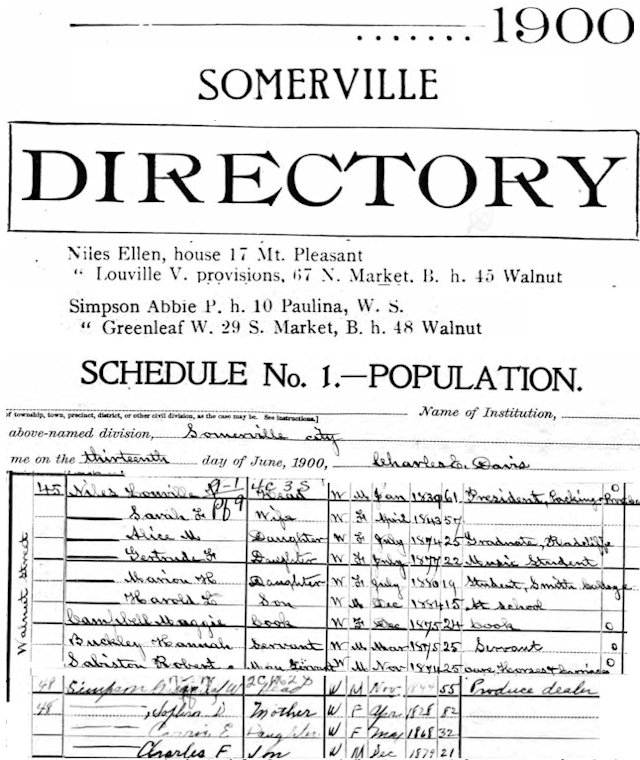 When Simpson got back to Somerville, he told his friend, Louville Veranus Niles, who lived across the street at 45 Walnut Street, about what he had seen in Texas. Niles was president of the Boston Packing and Provision Company.
When Simpson got back to Somerville, he told his friend, Louville Veranus Niles, who lived across the street at 45 Walnut Street, about what he had seen in Texas. Niles was president of the Boston Packing and Provision Company.
Simpson invited Niles to come with him to Texas for a look-see.
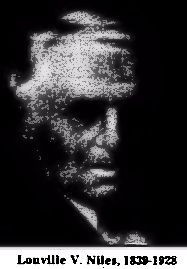 Niles liked what he saw.
Niles liked what he saw.
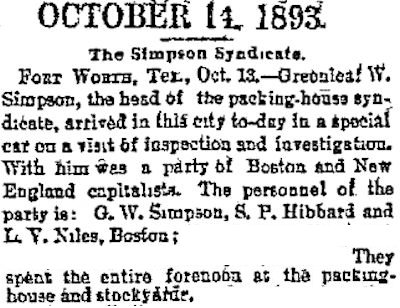 In 1893 Simpson and Niles and other investors chartered a new company, the Fort Worth Stock Yards Company. Simpson and Niles owned most of the stock in the new company. The new company was chartered in West Virginia, and when the new company issued its first stock certificates, its headquarters was listed as Boston. The new company bought both the Fort Worth Union Stock Yards and Fort Worth Packing Company lock, stock, and brisket.
In 1893 Simpson and Niles and other investors chartered a new company, the Fort Worth Stock Yards Company. Simpson and Niles owned most of the stock in the new company. The new company was chartered in West Virginia, and when the new company issued its first stock certificates, its headquarters was listed as Boston. The new company bought both the Fort Worth Union Stock Yards and Fort Worth Packing Company lock, stock, and brisket.
Also in 1893 Simpson promised Texas cattle raisers that if they would ship their cattle to the Fort Worth stockyards instead of the Kansas City stockyards, he would pay them fifty cents a head more than Kansas City paid.
Behind Simpson and Niles, the livestock industry north of the river began to move forward.
In 1895 the Fort Worth Live Stock Commission Company was chartered.
In 1896 the Fort Worth Stock Yards Company formed Fort Worth Stock Yards Belt Railway Company, which would build a railway connecting to trunk railroads to facilitate shipping of livestock and meat products. In 1896 the stockyards company also staged the first of Fort Worth’s annual stock shows.
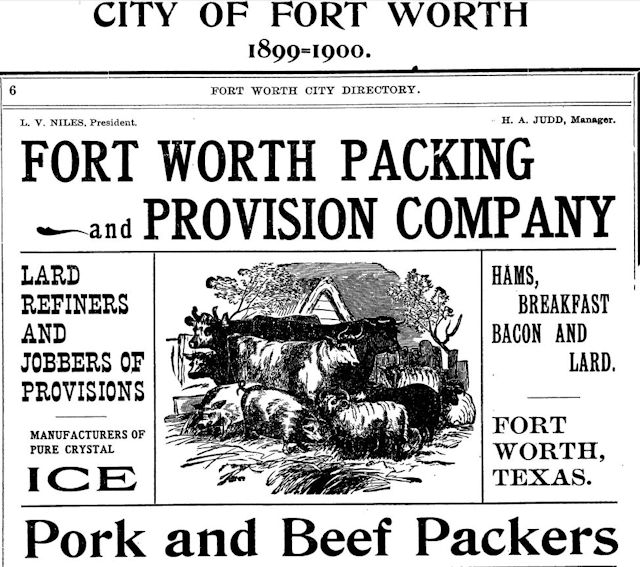 In 1899 Louville Niles leased the packing plant from Fort Worth Stock Yards Company and operated it as “Fort Worth Packing and Provision Company.” Niles also remained a director of the stockyards company.
In 1899 Louville Niles leased the packing plant from Fort Worth Stock Yards Company and operated it as “Fort Worth Packing and Provision Company.” Niles also remained a director of the stockyards company.
In 1899 Niles, at age sixty, began dividing his time between Massachusetts and Texas, staying six months of the year at the Stockyards Hotel near his packing plant. Because Simpson remained in Massachusetts, and other major stockholders of the stockyards company lived in Chicago, Texas cattle raisers got to know Niles better than they did the stockyards company’s other principals. Niles attended the stock show each year and maintained an interest in all aspects of the stockyards and packing plant, writing letters from Somerville when he was in residence there.
According to the Star-Telegram, under Niles profits at the packing plant “began soaring.”
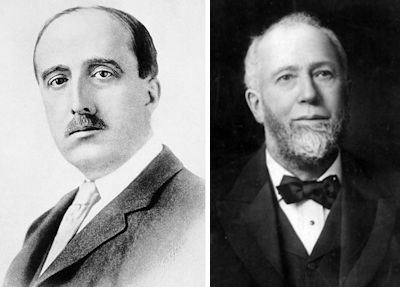 A south wind must have blown the scent of money north to Chicago because soon Louville Niles was visited by J. Ogden Armour (left) and Gustavus Swift (photos from Wikipedia).
A south wind must have blown the scent of money north to Chicago because soon Louville Niles was visited by J. Ogden Armour (left) and Gustavus Swift (photos from Wikipedia).
Armour and Swift were interested in Fort Worth as a branch location for their packing plants. Niles’s meatpacking operation was impressive. Fort Worth was surrounded by livestock. And Fort Worth had plenty of railroads to bring more livestock in and to ship meat products out.
But Armour and Swift wanted to be wooed. Won over. And they wanted more than roses, dinner, and a movie.
To seal the deal, Simpson and Niles agreed to give Armour and Swift land owned by the stockyards company on which to build the packing plants. Simpson and Niles agreed to reorganize their Fort Worth Stock Yards Company, giving one-third ownership each to Armour and Swift and keeping the remaining one-third for the two of them. They agreed to organize a bank and a townsite company and to provide other infrastructure that the sprawling stockyards-packing plants complex would need—with Armour and Swift again owning one-third each.
On top of that, the people of greater Fort Worth vowed to pass the hat to raise a $50,000 ($1.4 million today) bonus for each packer.
In return, Swift and Armour promised that all the livestock their packing plants received would pass through the Fort Worth Stockyards (of which Swift and Armour now owned two-thirds!).
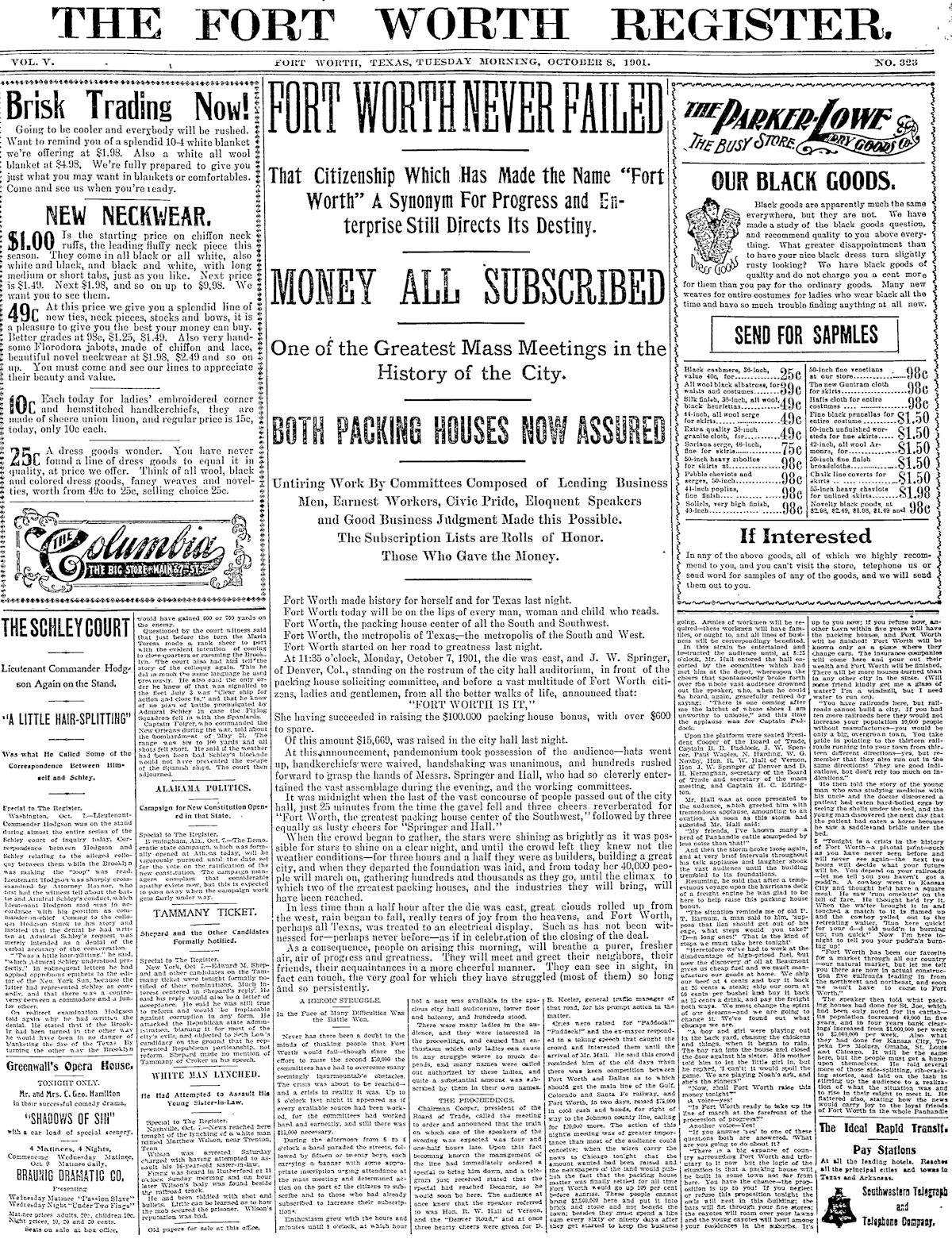 On October 8, 1901 the Fort Worth Register trumpeted the glad tidings: The people of Fort Worth had subscribed $100,000 to bring the two meatpacking giants to town. The banner story proclaimed: “Fort Worth, the packing house center of the South and Southwest. Fort Worth, the metropolis of Texas—the metropolis of the South and West.”
On October 8, 1901 the Fort Worth Register trumpeted the glad tidings: The people of Fort Worth had subscribed $100,000 to bring the two meatpacking giants to town. The banner story proclaimed: “Fort Worth, the packing house center of the South and Southwest. Fort Worth, the metropolis of Texas—the metropolis of the South and West.”
With the deal done, things happened quickly.
In 1901 the Fort Worth Live Stock Exchange was chartered. It would be housed in the Livestock Exchange Building (“the Wall Street of the West”), built in 1903.
In 1902, as construction of the two packing plants began, J. Ogden Armour was made president of the reorganized Fort Worth Stock Yards Company. Edward Swift, son of Swift founder Gustavus, was first vice president. Greenlief Wadleigh Simpson was second vice president.
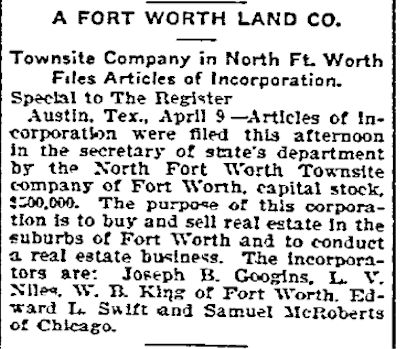 In 1902 the North Fort Worth Townsite Company was chartered to develop real estate in the stockyards-packing plants area. Among the company’s incorporators were Louville Niles and Edward Swift. (In 1906 the company would begin development of Belmont Terrace—the “new Quality Hill”—which included Grand Avenue.) Also in 1902 the city of North Fort Worth was incorporated (see Part 2).
In 1902 the North Fort Worth Townsite Company was chartered to develop real estate in the stockyards-packing plants area. Among the company’s incorporators were Louville Niles and Edward Swift. (In 1906 the company would begin development of Belmont Terrace—the “new Quality Hill”—which included Grand Avenue.) Also in 1902 the city of North Fort Worth was incorporated (see Part 2).
Also in 1902 the Armour company took over operation of Niles’s Fort Worth Packing and Provision Company but closed the plant the next year.
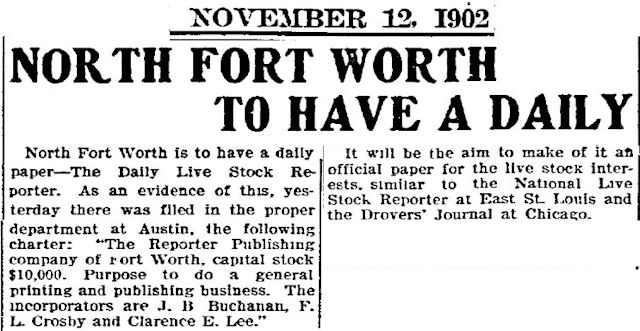 That same year the Reporter Publishing Company was chartered and began publishing the Daily Live Stock Reporter newspaper for North Fort Worth.
That same year the Reporter Publishing Company was chartered and began publishing the Daily Live Stock Reporter newspaper for North Fort Worth.
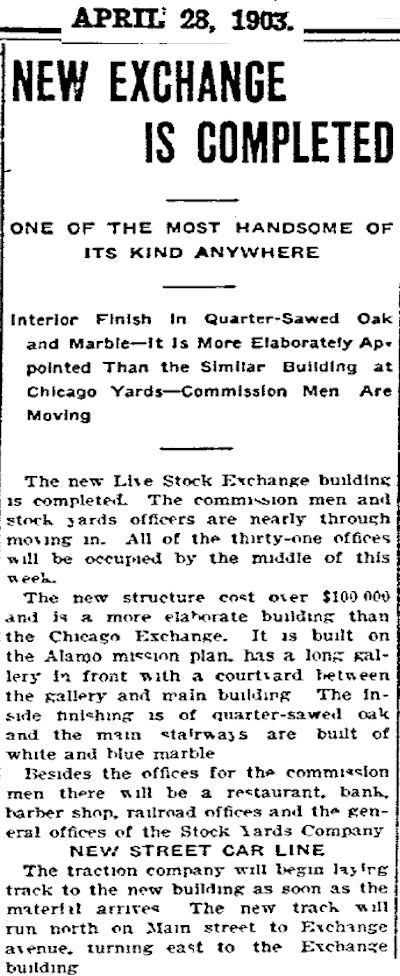 In 1903 the new Livestock Exchange Building—“the Wall Street of the West”—opened. Northern Texas Traction Company ran a new streetcar line from downtown Fort Worth to the building.
In 1903 the new Livestock Exchange Building—“the Wall Street of the West”—opened. Northern Texas Traction Company ran a new streetcar line from downtown Fort Worth to the building.
 The new packing plants opened in March 1903.
The new packing plants opened in March 1903.
Louville Niles’s success in steering Swift and Armour to town had put him out of a place to sleep: In 1902 the Stockyards Hotel, his home away from home, had been torn down to make way for the Swift compound.
Just as well: After the Armour and Swift plants opened and his closed, Niles returned to Somerville to live full-time and to attend to his Boston business interests. He was sixty-four years old.
 The stockyards-packing plants area continued to boom after Niles returned to Massachusetts. In 1907 construction of the coliseum began next to “the Wall Street of the West.”
The stockyards-packing plants area continued to boom after Niles returned to Massachusetts. In 1907 construction of the coliseum began next to “the Wall Street of the West.”
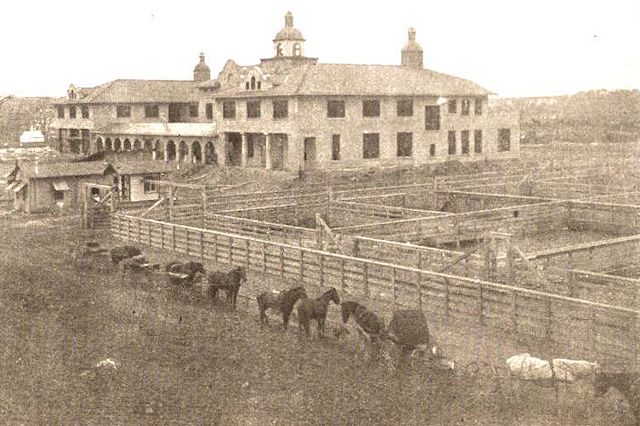

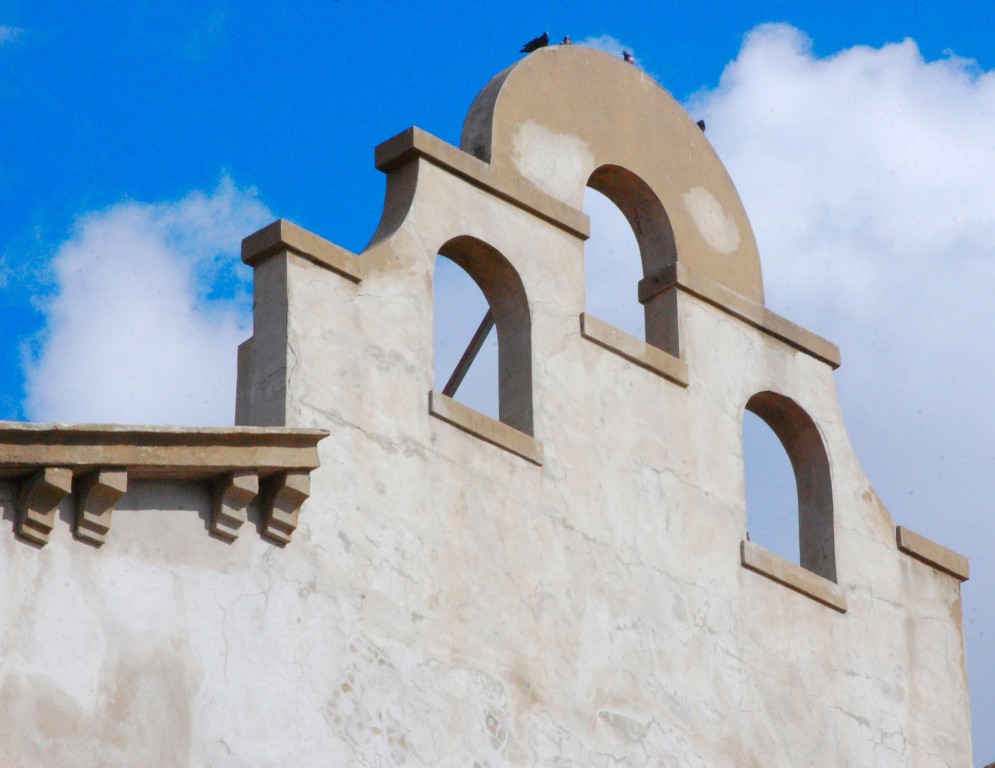
The stockyards company built the coliseum to house the annual stock show.

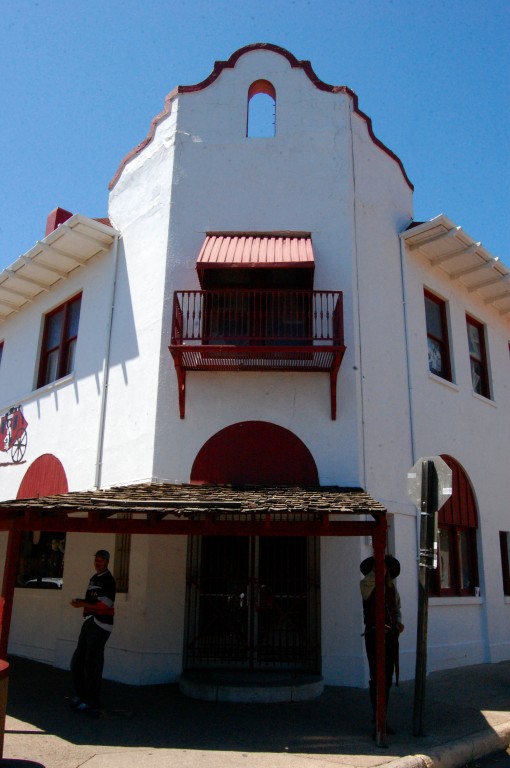 In 1910 the Fort Worth Stock Yards Company built a new home for its Stockyards National Bank. Among the bank’s directors were officers of Swift and Armour and Louville V. Niles.
In 1910 the Fort Worth Stock Yards Company built a new home for its Stockyards National Bank. Among the bank’s directors were officers of Swift and Armour and Louville V. Niles.
When Louville Veranus Niles died in 1928 the Boston Transcript newspaper wrote: “Fort Worth owes, in large measure, its present position as one of the leading livestock markets in the country to the vision and initiative of Mr. Niles.”
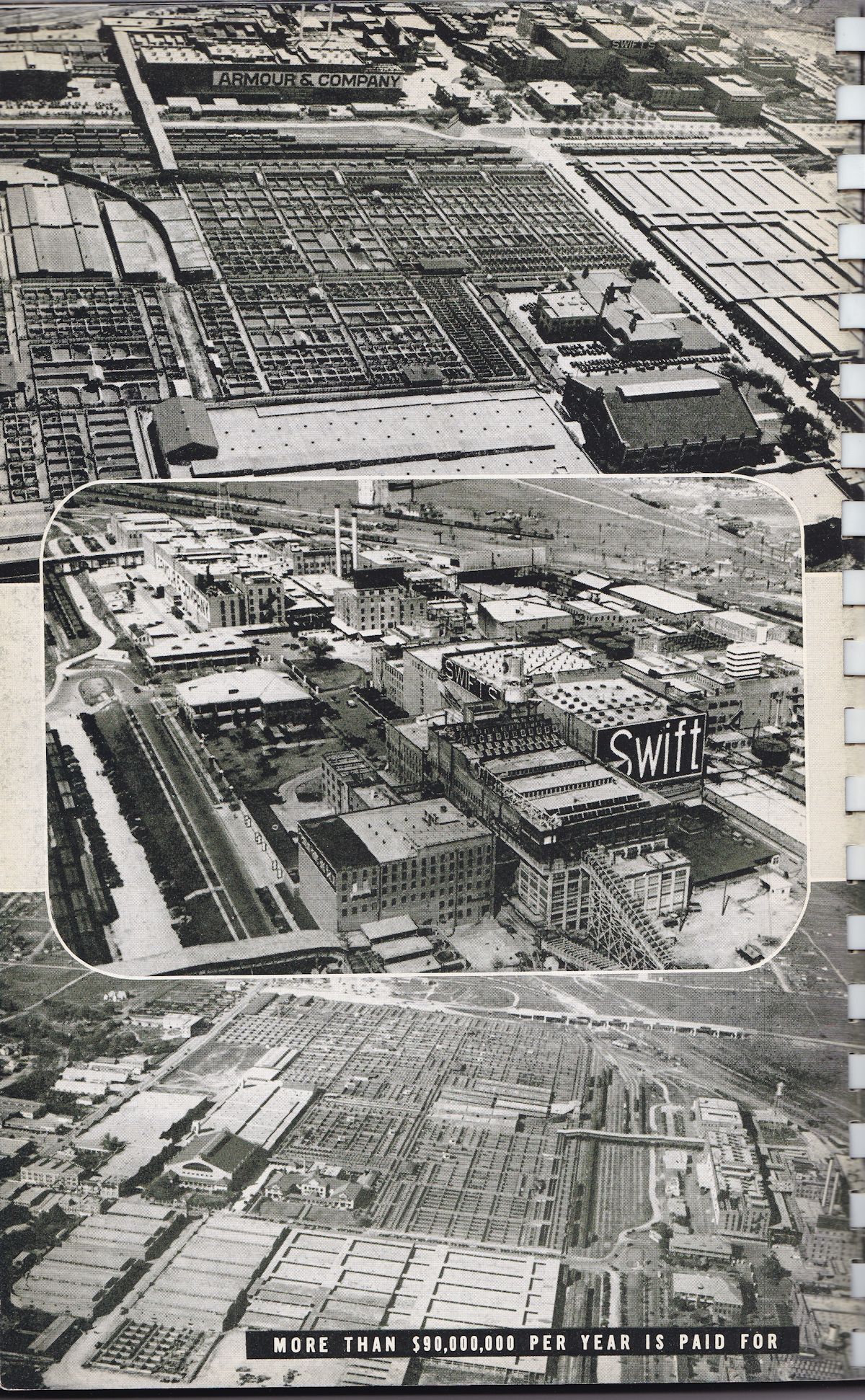 These 1940 W. D. Smith photos show the result of the “vision and initiative” of Simpson and Niles: The stockyards-packing plants complex stretched from Northeast 23rd Street north to Northeast 29th Street and from North Main Street east to the Frisco railroad tracks.
These 1940 W. D. Smith photos show the result of the “vision and initiative” of Simpson and Niles: The stockyards-packing plants complex stretched from Northeast 23rd Street north to Northeast 29th Street and from North Main Street east to the Frisco railroad tracks.
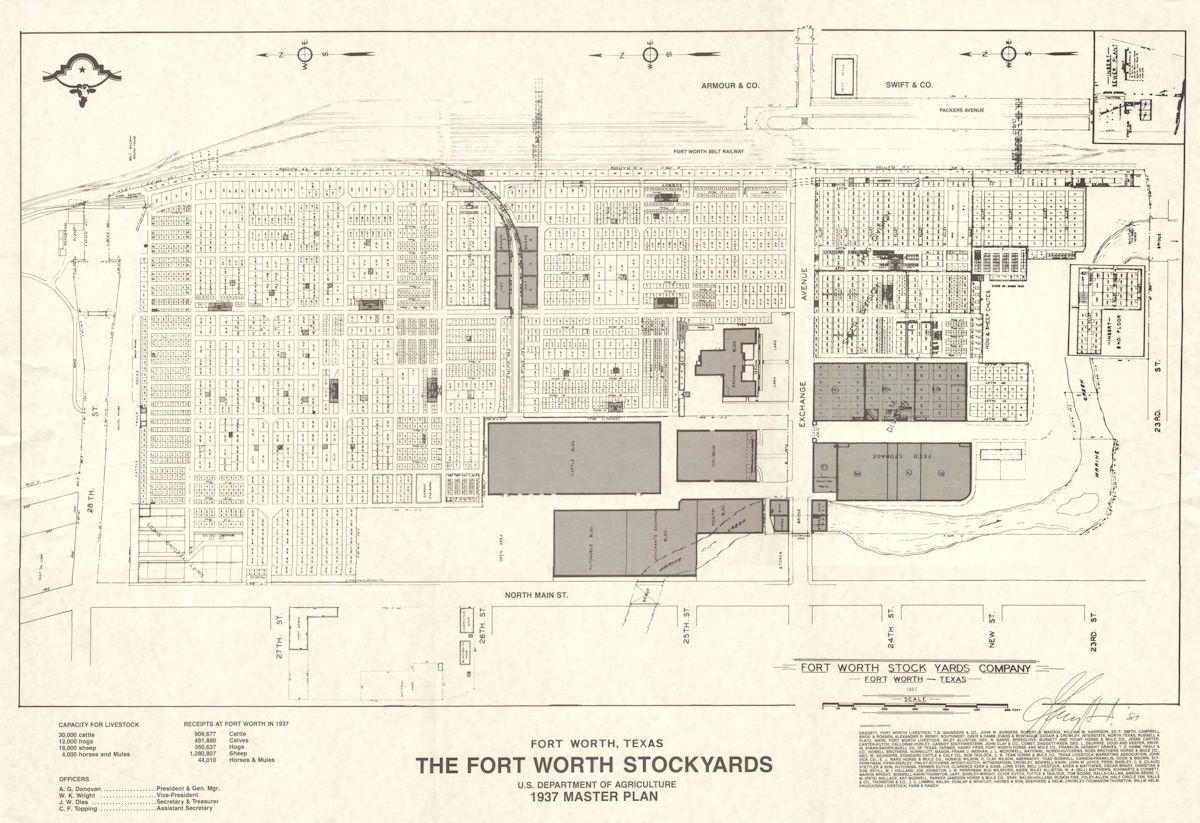 The complex employed workers in the thousands and generated revenue, wages, and taxes in the millions. (From Pete Charlton’s “1000+ Lost Antique Maps of Texas & the Southwest on DVD-ROM.”)
The complex employed workers in the thousands and generated revenue, wages, and taxes in the millions. (From Pete Charlton’s “1000+ Lost Antique Maps of Texas & the Southwest on DVD-ROM.”)
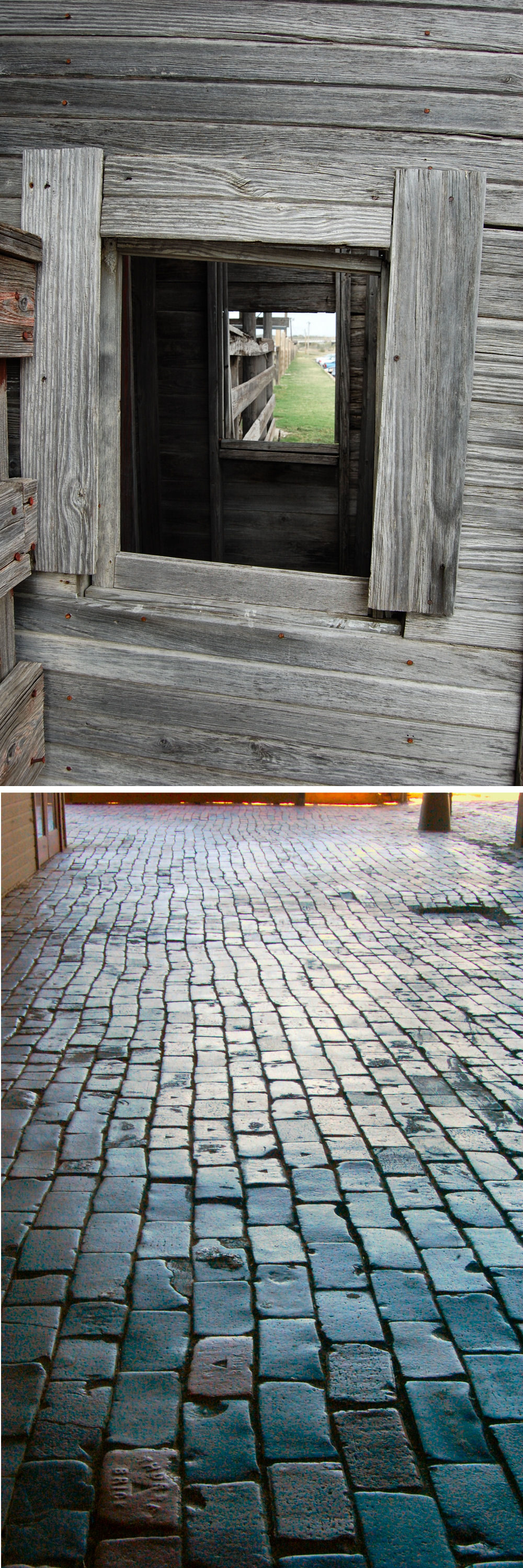 Miles of boards, acres of bricks.
Miles of boards, acres of bricks.
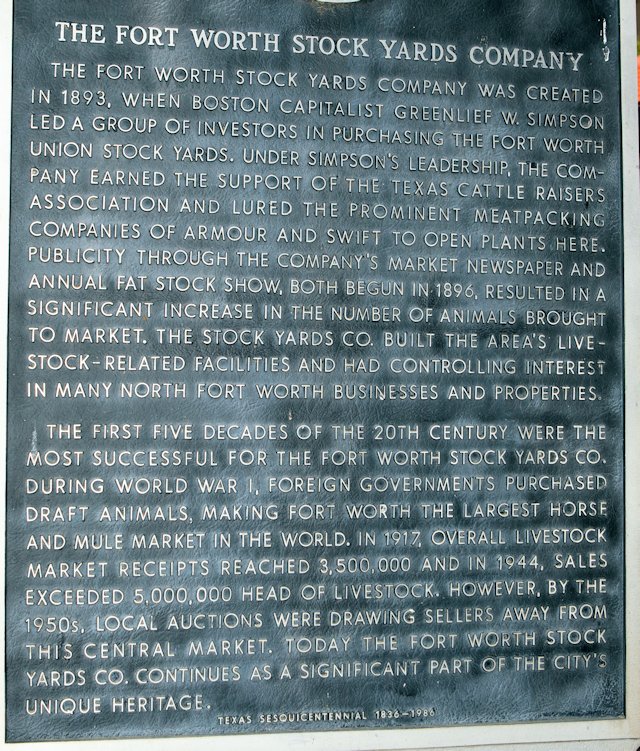 Today, of course, the stockyards-packing plants area is a historic district, not an industrial district.
Today, of course, the stockyards-packing plants area is a historic district, not an industrial district.
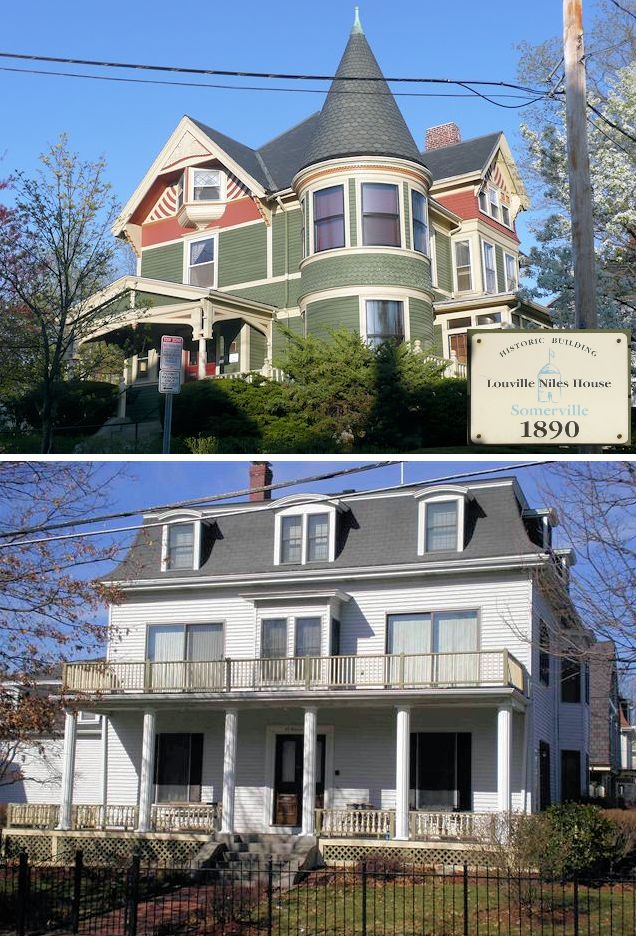 And there are few reminders of the two men from Walnut Street in Somerville, Massachusetts who were largely responsible for developing the stockyards and packing plants and helping to create “the Wall Street of the West.”
And there are few reminders of the two men from Walnut Street in Somerville, Massachusetts who were largely responsible for developing the stockyards and packing plants and helping to create “the Wall Street of the West.”
But at the northwest and southwest corners of the Swift compound, in the 500 blocks of Exchange Avenue and Northeast 23rd Street, are two street signs:
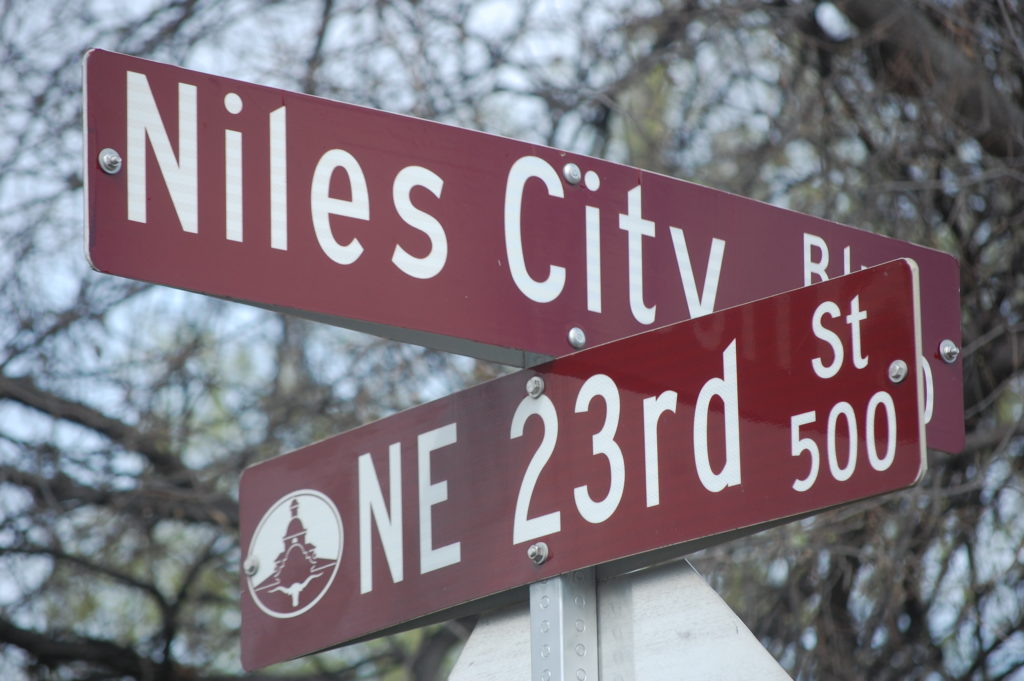 What was Niles City? That’s a whole ’nuther story in itself, pardner:
What was Niles City? That’s a whole ’nuther story in itself, pardner:
Connections: From Walnut Street to “the Wall Street of the West” (Part 2)






Hi,
I hope this message finds youwell ,
I am a tech expert with experience of over a decade in the industry. If you want any bugs fixed or want a redesigning on your website, do not hesitate to reach out to me on sitesmartwp@gmail.com.
Looking forward to yourresponse ,
Regards.
We are currently already working on a solution for this site and do not need these services. The author has passed away. Thank you
Are there any copies of the 1937 master plan of The Fort Worth Stockyards? If so where would I get one and at what cost?
Thank you for visiting the site. Unfortunately the author, Mike Nichols, passed away and we are working on how best to preserve this informative site.
Hello!! Love your website. Has been super helpful with information about Fort Worth that you can’t really find anywhere. Could you please send me a digital version of the Stockyards 1937 master plan? Also, do you happen to have any historical pictures at all of N Main Street, near Cattlemen’s Steakhouse, between 1942-50? I am trying to get a street view after the 1942 flood that destroyed the La Plaza building portion that was built over the Marine Creek. Would be super grateful.
Thanks for visiting this site. Unfortunately the author, Mike Nichols, has passed away. We are currently working to find a solution to best preserve this informative website.
Do you know where to purchase a copy of the Fort Worth stockyards 1937 master plan? I saw a copy in Billy bobs and would like to purchase one if possible. Thanks
Mr. Mercier, I have e-mailed you the only digital version I know of. The Stockyards Museum might have a print.
Thank you so much for this awesome article. We are working on a video piece on the Fort Worth Stockyards and desperately looking for an image of Niles (which you have on this page). We were wondering if that was an actual image you found, or an image that you just made to look old enough that it could have been anyone? Thank you for your help on this!
Thanks. I have e-mailed you a link to the source.